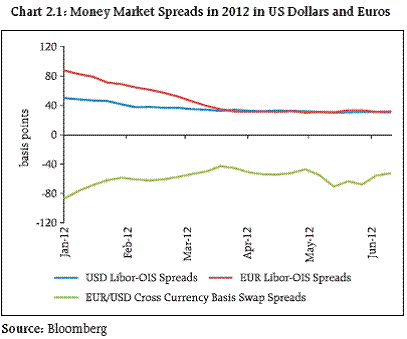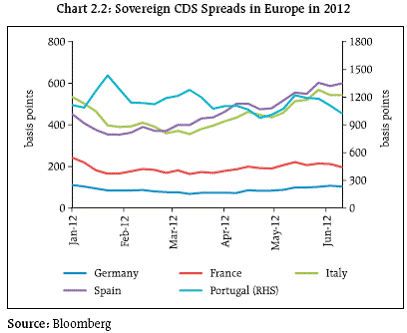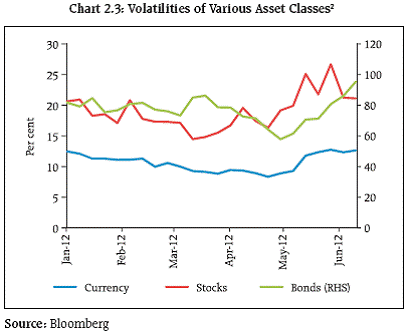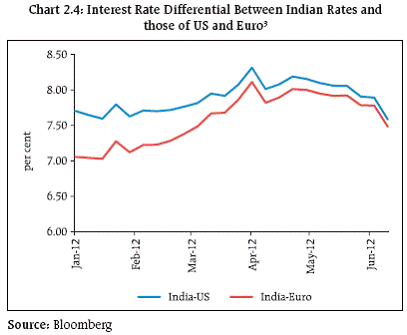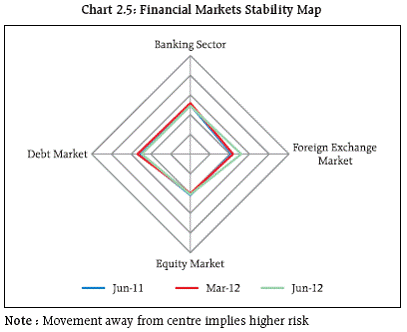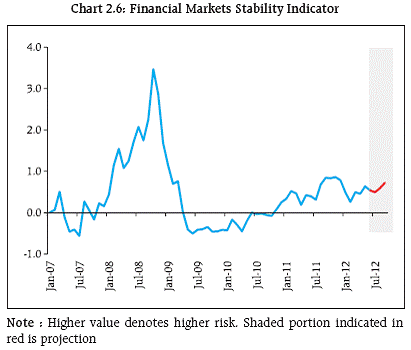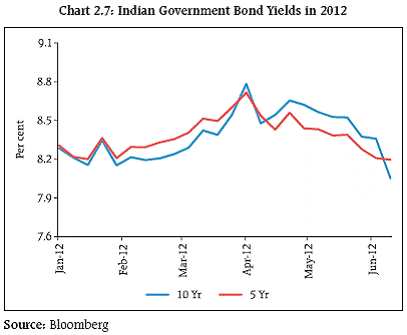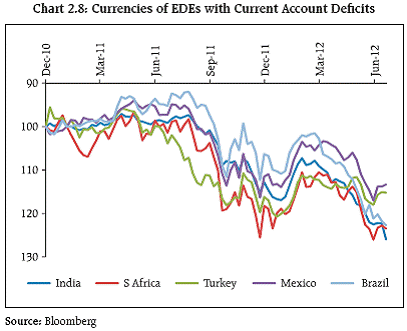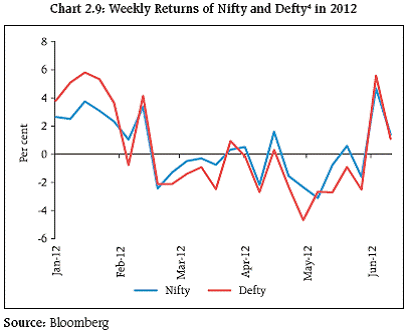Chapter II : Financial Markets - ربی - Reserve Bank of India
Chapter II : Financial Markets
Globally, uncertainty and risk aversion reigned in the financial markets as sovereign default risk, fragility in the banking sector and funding strains for sovereigns and banks continued to haunt the Euro area. Policymakers, posed with fresh challenges, had to innovate constantly to address the panic and keep the markets stable. Unconventional policy measures have been initiated by governments and central banks during the last two years, to deal with the situation. While the measures have brought temporary respite to the financial markets and the economies, the structural nature of the problems persist and the Eurozone crisis, remains a major threat to global financial stability. The improvement in sentiment in the early part of 2012 has given way to gloom as popular dissent against tough austerity measures has made it difficult for democratically elected governments to act. The concerns of a Greek exit from the European monetary union increased uncertainty during the period under review. The falling momentum in domestic growth in India as well as the rising current account deficit and the growing fiscal gap are eroding investor confidence. While the domestic money and bond markets remain relatively unaffected by external turbulence, the foreign exchange and equity markets have witnessed high levels of volatility. A combination of foreign exchange market intervention and administrative measures have been taken to address the stress in foreign exchange markets. Sentiment in Indian equity markets is likely to remain tied to developments in global and domestic macroeconomic situation. I. Global Markets Lingering European debt crisis cast a shadow on financial markets 2.1 The European sovereign debt crisis had caused funding strains for sovereigns and, in their wake, for European banks since the onset of the financial crisis. This intensified towards the end of 2011. There was persistent uncertainty over the exact terms of fiscal relief for Greece. The rating downgrades of European banks and sovereigns have added to the strains experienced by financial markets. ECB’s policy support rescued sentiment temporarily 2.2 Stronger than expected US economic data and the European Central Bank (ECB)’s first three-year Longer- Term Refinancing Operation1 (LTRO) in December 2011 were mainly responsible for changing market sentiment in early part of 2012 as investor risk appetite recovered. The ECB followed up the first round of LTRO in December 2011 with another one in February 2012, taking the total policy support from this measure to over €1 trillion. The LTROs provided finance for stressed sovereigns and banks. Bank and sovereign CDS spreads tightened significantly. Strains in US dollar funding markets appeared to ease (Chart 2.1). Sovereign debt sustainability concerns resurfaced... 2.3 Policy measures proved unsuccessful in providing sustained relief. The broad financial market rally that followed the unconventional monetary policy measures taken in late 2011 and early 2012 has subsided. Global markets were concerned about elevated risks from Greece during the period under review (Box Item 2.1). While the size of firewalls for fiscal risks in Europe have been raised, doubts over their capacity to support larger countries such as Spain or Italy in case of a contagion, have weakened market confidence. ...with widening of spreads on sovereign bonds 2.4 Sovereign CDS spreads have widened significantly, especially in Spain and Italy (Chart 2.2). Several institutions lowered risk limits for sovereign bonds of the troubled economies in Eurozone due to adverse developments and the higher notional losses on such bond holdings (as a result of higher volatility). This reduced the institutional appetite for bonds and affected their liquidity. The implied volatilities of the bond, stock, and foreign exchange markets point to an uncertain environment (Chart 2.3). Structural issues remain to be addressed 2.5 Some European banks continue to be heavily reliant on wholesale funding. However, the maturities of bank borrowings have been shortened owing to market conditions. Further, their access to unsecured funds has also worsened. This fragility makes banks vulnerable to funding market freezes and has significantly increased their dependence on central bank support. Rating agency, Moody’s Investor Service cut ratings of 15 major banks by one to three notches, in another round of rating downgrades in mid-June 2012. Greece received a second bailout package from the IMF-EU-ECB troika in February 2012 after its fiscal situation failed to improve to the extent expected. The second restructuring involved an effective loss of as much as 75 percent for private bond holders in order to reduce Greece’s debt burden. Outcomes of recent elections in Europe point to anti-incumbency on account of austerity measures. The contrasting experiences of Ireland and Iceland are a pointer for the Greek situation. Ireland, which is in the Euro currency union, is still on negative growth trajectory, despite adhering to austerity measures imposed by lenders. Iceland, in contrast, has rebounded with good growth rates in 2011 through depreciation of its currency and by passing on losses to its lenders. Iceland grew at 4.5 per cent in Q1 2012 compared to 0 per cent for the European Union. In fact, the central bank of Iceland has been hiking interest rates since Q3 2011. The outcome of the second election in Greece in June 2012 appears to favour the continuation of Greece in the monetary union. Accommodative monetary policy in advanced countries has externalities 2.6 In the United States, macroeconomic indicators point to a slow recovery, though the sustainability of the recovery remains uncertain. Central banks in advanced economies (AEs) are continuing their accommodative monetary policies. Policy rates have been at or near historic lows in many AEs, with a commitment to continue these levels for some more time. This, in turn, induces greater leverage and a progressive easing of lending standards. From a corporate issuer’s point of view, the cost of raising fund by issuance of bonds has become more attractive, relative to equity. A surge in corporate borrowings could increase systemic leverage in the process. There are signs that continuously low interest rates may start to feed into a search-for-yield behaviour in global financial markets (Chart 2.4). II. Domestic Markets Foreign exchange market exhibited considerable stress 2.7 Developments in Euro area and deterioration in global macroeconomy were among the factors that contributed to stress in the domestic foreign exchange market during the period under review. The other three components of the Financial Markets Stability Map (Chart 2.5), viz. banking sector funding, debt and equity markets, remained largely unchanged in comparison. The rise in the Financial Markets Stability Indicator (Chart 2.6) is largely driven by the fall in the rupee to historical lows and rise in its volatility. Sovereign bond yields reflected fiscal slippages 2.8 Bond yields moved higher towards the end of March and early April 2012 (Chart 2.7) on account of persistently tight liquidity conditions and an unanticipated rise in budgeted government borrowings for 2012-13. Subsequently they have stayed in a range between 8.5 per cent and 8.8 per cent for 10-year maturities. The financial markets remained unconvinced about the ability of the government to bring down the high level of fiscal deficit. The gross and net market borrowing of the Central Government through dated securities have been budgeted at ` 5696 billion and ` 4790 billion, respectively during 2012-13. This is higher by 11.7 per cent and 9.8 per cent, respectively over the last year. The Central Government proposes to finance only 2 per cent of the budget through treasury bills, significantly lower than 22 per cent in 2011-12. A cut in the Reserve Banks’ policy rate by 50 basis points, inter alia, brought 10-year government bond yields closer to 8 per cent. Indian sovereign bond market remained largely insulated from overseas pressures 2.9 During the period under review, the rating agencies, S&P and Fitch, changed the outlook on Indian sovereign debt and 11 banks /institutions, from stable to negative. Though the government bond yields rose marginally on the news of change in the rating outlook, they quickly retraced. Since the Central Government does not borrow in the offshore markets and reliance on outside investors by way of Foreign Institutional Investment (FII) is limited, the impact was muted. Liquidity conditions improved after tightness in March 2.10 Liquidity conditions in Indian money market remained tight, during the period under review, outside of the Reserve Bank’s indicative comfort level of (+)/(-) one per cent of net demand and time liabilities (NDTL) of banks. Average net injection of liquidity under the daily liquidity adjustment facility (LAF) increased from around `0.5 trillion during April-September 2011 to around `1.6 trillion during March 2012. The increase in currency in circulation, quarterly tax outgo from all firms and the foreign exchange market intervention operations sucked liquidity out of the banking system. The Reserve Bank injected liquidity by conducting open market operations (OMOs) and reducing the cash reserve ratio (CRR) by 125 basis points. The Systemic Liquidity Indicator (Chapter V) exhibits the stress felt in funding liquidity for banks and others. Rating change could impact the cost and availability of foreign currency borrowing 2.11 The process of deleveraging underway among European banks has raised the cost of borrowing for Indian firms and banks. Smaller borrowers have found their traditional funding lines withdrawn. A large part of foreign currency borrowings of Indian firms and banks is in the form of loans (External Commercial Borrowings) rather than bonds. The current external rating of India stands at BBB- (with a negative watch by S&P and Fitch and Baa3 by Moody’s). A rating change could have some ‘cliff effects’. This could affect both availability and cost of foreign currency credit lines for Indian corporates further. The impact is also being felt by Indian banks as they are the primary source of foreign currency denominated funding for Indian firms like buyer’s credit. Indian financial institutions and non-banking financial companies (NBFCs) in the public sector have been large beneficiaries of FII investments in debt in the past. These institutions, could also face the impact of a reduction in FII inflows. Forex market remained volatile 2.12 Concerns over high twin deficits of the country, re-emergence of global macroeconomic tensions and the European sovereign debt crisis have been the key factors behind the weakening rupee. The Reserve Bank has been using a mix of foreign exchange market interventions and administrative measures to address the volatility arising from tensions in the market place. The depreciation of the rupee followed the general trend of currencies of EDEs, especially those with high current account deficits (Chart 2.8). Reserves fell moderately 2.13 Adequacy of reserves has emerged as an important parameter in gauging the ability of a country to absorb external shocks. At the end of September 2011, the import cover declined to 8.5 months from 9.6 months at end-March 2011.The ratio of short-term debt to the foreign exchange reserves was 21.3 per cent at end- March 2011 and it increased to 23 per cent at end- September 2011. The ratio of volatile capital flows (defined to include cumulative portfolio inflows and short-term debt) to the reserves increased from 67.3 per cent as at end-March 2011 to 68.3 per cent as at end- September 2011. 2.14 With the changing profile of capital flows, the traditional approach of assessing reserve adequacy in terms of import cover has been broadened to include a number of parameters which take into account the size, composition and risk profiles of various types of capital flows as well as the types of external shocks to which the economy is vulnerable. In the recent period, assessment of reserve adequacy is being done using some new measures, including ‘Liquidity at Risk’ (LaR). The LaR approach requires that a country’s foreign exchange liquidity position could be calculated under a range of possible outcomes for relevant financial variables, such as, exchange rates, commodity prices, credit spreads etc. Recent Rupee weakness found echo in stock market sentiment 2.15 The Morgan Stanley Capital International (MSCI) Emerging Markets index reported a first quarter gain of 13.2 per cent in Q1 2012. Stock markets in India mirrored the movement in other emerging markets in Asia and elsewhere. The initial optimism fuelled by increased liquidity provided by ECB and the resolution of uncertainties relating to the second debt package for Greece quickly waned. Retrenchment by FIIs in India (as also abroad) led to a correction in Indian stock indices back to their December 2011 lows. The US dollar rate of return to foreign investors worsened with the depreciation of the Indian rupee and this, in turn, reduced the attractiveness of Indian equity (Chart 2.9). Some episodes have highlighted the possible risks from Algo and High Frequency Trades 2.16 In recent period, there have been many instances of extreme volatility and disruptions witnessed in Indian stock markets, resulting from various causes which can be directly or indirectly attributed to the increasing use of Algorithmic5 (Algo) and High Frequency Trading (HFT)6. The Financial Stability Report of June 2011 had mentioned about the possible risk implications of a rapid move towards technological advancements like introduction of Direct Market Access (DMA)7, facilitating Algo trading and HFT for Indian stock markets. In India only about 17 per cent and 11 per cent of cash market turnover in NSE and BSE respectively are on account of Algo and HFT in recent months. This proportion is much lower than that in developed markets like US and Europe. 2.17 Indian stock exchanges already have features like circuit breakers on stocks (having derivative trading) and indices, dummy price band for no band securities, quantity alert check, consolidated audit trail and trade cancellation policy and other risk reduction procedures to detect manipulation and deal with the possible risks. There is a need to balance the need for technological advancements with a pragmatic approach to the intended benefits of the innovations. This assumes even more significance for India as efforts are being made to increase the retail participation in the Indian securities markets to change the largely institutional character of the market. The regulators and policy makers need to continue to assess the system-wide impact of such trading, from the perspective of current priority for a broad-based development of financial markets. 1 The ECB usually conducts overnight, weekly and monthly repos. During the financial crisis, it started conducting longer term repos for 1-year maturities. This program was expanded further for unlimited sums for three years with considerable relaxation in quality and nature of collateral accepted. 2 Volatilities are represented for currencies by 1-month implied vols of EUR/US$, for equities by US’ VIX index and for bonds by the Merrill Lynch’s MOVE index for US treasuries. 3 10-year rates on Indian government bonds are used as investment and US dollar and Euro Libor rates are used as borrowing rates. 4 Defty is the S&P CNX Defty index and is a Dollar denominated value of NSE’s Nifty Index. 5 Algo trading refers to the use of electronic platforms for entering trading orders with a computer program (algorithm) determining the decisions on aspects such as the timing, price, or quantity of the order, or in many cases initiating the order without human intervention. 6 The HFT is a special class of Algo trading, in which computers make elaborate decisions to initiate orders based on electronically accessed information, at a very fast speed (in microseconds), before human traders are capable of processing the information they observe. 7 Direct Market Access (DMA) is a facility that allows ‘clients’ to directly access the broker’s trading infrastructure (linked to the exchange trading system) without any manual intervention by the broker, resulting in advantages such as direct control over and faster execution of client orders, orders, reduced risk of errors associated with manual order entries, greater transparency, increased liquidity, lower impact costs for large orders, better audit trails and better use of hedging and arbitrage opportunities through the use of decision support tools/algorithms for trading. |













